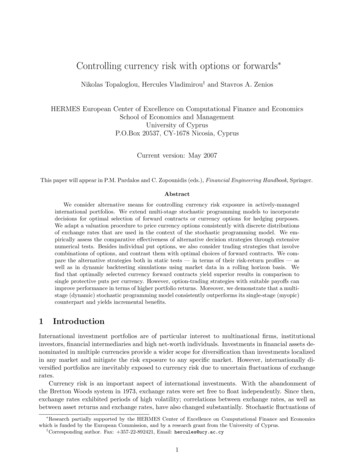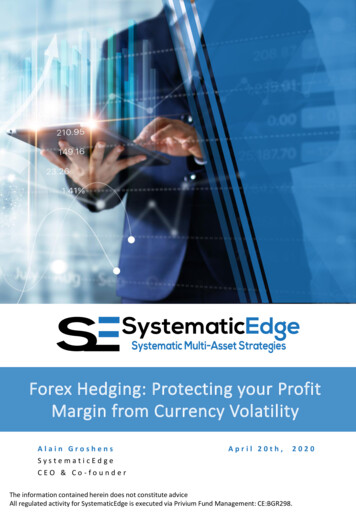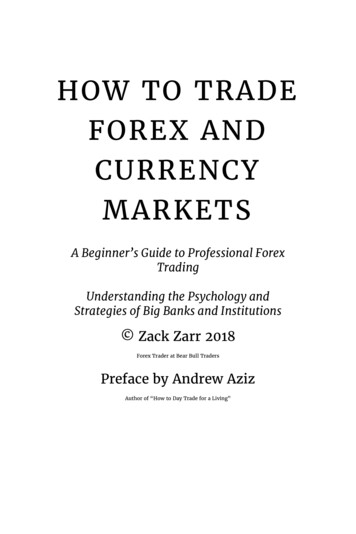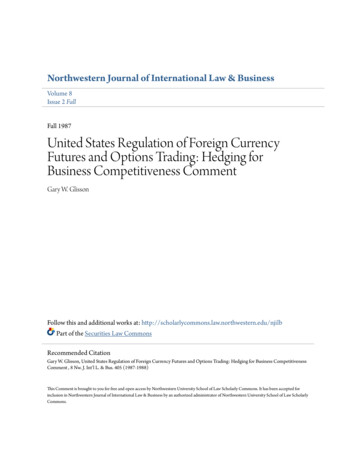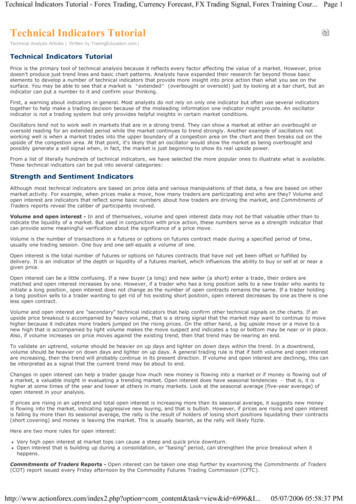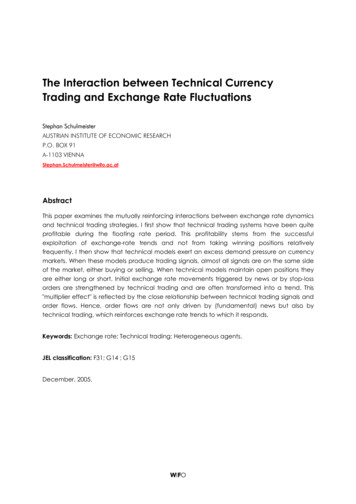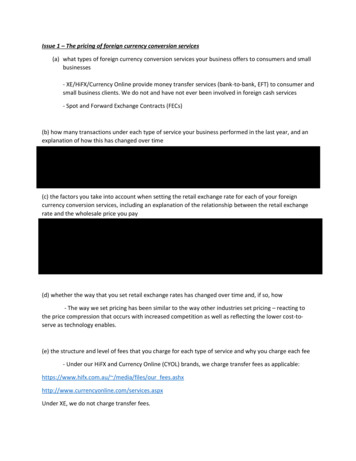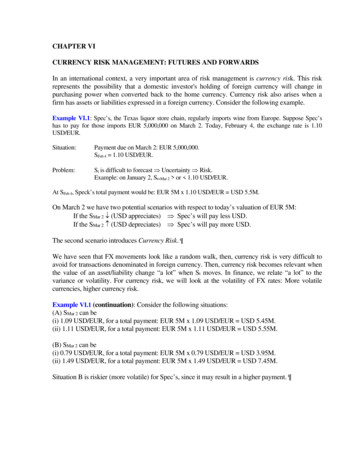
Transcription
CHAPTER VICURRENCY RISK MANAGEMENT: FUTURES AND FORWARDSIn an international context, a very important area of risk management is currency risk. This riskrepresents the possibility that a domestic investor's holding of foreign currency will change inpurchasing power when converted back to the home currency. Currency risk also arises when afirm has assets or liabilities expressed in a foreign currency. Consider the following example.Example VI.1: Spec’s, the Texas liquor store chain, regularly imports wine from Europe. Suppose Spec’shas to pay for those imports EUR 5,000,000 on March 2. Today, February 4, the exchange rate is 1.10USD/EUR.Situation:Payment due on March 2: EUR 5,000,000.SFeb 4 1.10 USD/EUR.Problem:St is difficult to forecast Uncertainty Risk.Example: on January 2, St Mar 2 or 1.10 USD/EUR.At SFeb 4, Speck’s total payment would be: EUR 5M x 1.10 USD/EUR USD 5.5M.On March 2 we have two potential scenarios with respect to today’s valuation of EUR 5M:If the SMar 2 (USD appreciates) Spec’s will pay less USD.If the SMar 2 (USD depreciates) Spec’s will pay more USD.The second scenario introduces Currency Risk. ¶We have seen that FX movements look like a random walk, then, currency risk is very difficult toavoid for transactions denominated in foreign currency. Then, currency risk becomes relevant whenthe value of an asset/liability change “a lot” when St moves. In finance, we relate “a lot” to thevariance or volatility. For currency risk, we will look at the volatility of FX rates: More volatilecurrencies, higher currency risk.Example VI.1 (continuation): Consider the following situations:(A) SMar 2 can be(i) 1.09 USD/EUR, for a total payment: EUR 5M x 1.09 USD/EUR USD 5.45M.(ii) 1.11 USD/EUR, for a total payment: EUR 5M x 1.11 USD/EUR USD 5.55M.(B) SMar 2 can be(i) 0.79 USD/EUR, for a total payment: EUR 5M x 0.79 USD/EUR USD 3.95M.(ii) 1.49 USD/EUR, for a total payment: EUR 5M x 1.49 USD/EUR USD 7.45M.Situation B is riskier (more volatile) for Spec’s, since it may result in a higher payment. ¶
How do we measure FX risk in FX markets? We use the distribution of st to understand andmeasure FX risk. Below, Table VI.1 presents the distribution of st (with annualized mean & SD)from 1990:Jan - 2017:Dec, using monthly data.TABLE VI.1Distribution of Changes in Exchange Rates for Selected Currencies ness 60--No Observations (typical of financial time series):- On average, the USD appreciated against international currencies at an annualized mean of3.50%. The average annualized SD is 11.80%.- Against developed currencies: 0.54% annualized change (SD 9.51%)
- Excess Kurtosis. It describes the fatness of the tails. Under normality, excess kurtosis equals 0.All the currencies show excess kurtosis, that is, the tails are fatter than the tails of a normal –i.e.,probability of a tail event is higher than what the normal distribution implies.- Skewness. If the distribution is symmetric (mean median, for example, a normal), skewness is 0.Almost all the currencies show positive skewness (mean median); that is, the fat part of the curveis on the left.- st does not follow a normal distribution, as clearly seen in Graph VI.I.Graph VI.1 show the histogram and empirical distribution (in red) of changes in the GBP/USD. Itis the typical behavior of a developed currency (against the USD).GRAPH VI.1Distribution of monthly changes in the GBP/USD exchange rate (1990-2017)FX volatility is a serious concern for many companies, especially during times of turbulence inFX markets, where extreme behavior can substantially swing the cash flows of firms (excesskurtosis helps to point out series with big swings). The following example illustrates this point:the Thai cement giant, Siam City Cement, had big losses during the 1997 Asian Financial crisis,mainly due to liabilities denominated in foreign currency.Example VI.2: On July 2, 1997, Thailand devalued its currency, the baht (THB), by 18%. Siam CityCement, Thailand's second largest cement producer, lost THB 5,870 million (USD 146 million), giving a
net deficit for the nine-month period of 1997 of THB 5,380 million. Siam City Cement reported a net profitof THB 817 million during the first nine months of 1996. Industry analysts said that the company wasaffected by foreign exchange losses on USD 590 million foreign debt, reported as of June 30. ¶These examples show that FX risk is a serious concern for companies and investors ininternational markets. Managing this risk is very important. Chapter I introduced the instrumentsof currency risk management. This chapter studies the use of futures and forward contracts tolessen the impact of currency risk on positions denominated in foreign currencies. The nextchapter studies currency options as a currency risk management tool.I. Futures and Forward Currency ContractsBefore we start talking about futures and forwards, we have to answer an important question: whydo we care about futures or forward contracts? In order to answer this question, we should recallthat the primary goal of risk management is to change the risk-return profile of a cash position (orportfolio) to suit given investment objectives. This involves one of three alternatives: preservingvalue, limiting opportunity losses, or enhancing returns. Futures and forward contracts areeffective in meeting these risk management objectives because they can be used as cost-efficientsubstitutes or proxies for a cash market position. The determination of the proper equivalencyratio is critical to the use of futures or forwards as a cash market proxy, regardless of whether thisratio will be applied to a hedge, an income enhancement strategy or a speculative position. Thedifference between futures and forward contracts is the subject of Section I. The determination ofthe proper equivalency ratio is the subject of Section II.1.AFutures and Forwards Contracts in Risk ManagementThis section presents the basic differences between futures and forwards. They are instrumentsused for buying or selling a stated amount of foreign currency at a stated price per unit at aspecified time in the future. When a forward or futures contract is signed there is no up-frontpayment. Both forward and futures contracts are classified as derivatives because their values arederived from the value of the underlying security. Forward and futures contracts play a similarrole in the management of currency risk. The empirical evidence shows that both contracts do notshow significantly different prices. Although a futures contract is similar to a forward contract,there are many differences between the two.1.A.1 Forward ContractsChapter I introduced forward contracts. A forward contract is a tailor-made contract. Forwardcontracts are made directly between two parties, and there is no secondary market. In general, atleast one of the parties is a bank. Forward contracts are traded over the counter: traders andbrokers can be located anywhere and deal with each other over the phone. To reverse a position,one has to make a separate additional forward contract. Reversing a forward contract is notcommon. Ninety percent of all contracts result in the seller making delivery of the underlyingcurrency.
Forward contracts are quoted in the interbank market for maturities of one, three, six, nine and 12months. Non-standard maturities are also available. For good clients, banks can offer a maturityextending out to 10 years.In Example I.8, 30-, 90-, and 180-day forward rate quotations appear directly under the Canadiandollar. The Wall Street Journal presents similar forward quotes for the other five majorcurrencies: JPY, GBP, DEM, FRF, and CHF. These quotes are stated as if all months have 30days. A 180-day maturity represents a six-month maturity. In general, the settlement date of a180-day forward contract is six calendar months from the spot settlement date for the currency.For example, if today is January 21, 1998, and spot settlement is January 23, the forwardsettlement date would be April 23, 1998, a period of 92 days from January 21.1.A.2 Futures ContractsA futures contract has standardized features and is exchange-traded, that is, traded on organizedexchanges rather than over the counter. Foreign exchange futures contracts are for standardizedforeign currency amounts, terminated at standardized times, and have minimum allowable pricemoves (called "ticks") between trades. Foreign exchange futures contracts are traded on themarket floor of several exchanges around the world. For example, they are traded on the ChicagoMercantile Exchange (the "Merc"), the Tokyo International Financial Futures Exchange (TIFFE),the Sydney Futures Exchange, the New Zealand Futures Exchange, the MidAmericaCommodities Exchange, the New York Futures Exchange, and the Singapore InternationalMonetary Exchange (SIMEX).The CME is the biggest and most important market in the world for foreign exchange futurescontracts. CME futures contracts have been copied by other organized exchanges around theworld. CME futures are quoted in direct quotes -U.S. dollar price of a unit of foreign exchange.CME futures specify a contract size, that is, the amount of the underlying foreign currency forfuture purchase or sale, and the maturity date of the contract. Futures contracts have specificdelivery months during the year in which contracts mature on a specified day of the month.Contracts are traded on the traditional three-month cycle of March, June, September, andDecember. In addition, a current month contract is also traded. For some currencies, however, theCME offers currency futures with additional expiration dates. For example, for the GBP and theEUR contracts, the CME also offers January, April, July, and October as expiration dates. Themonth during which a contract expires is called the spot month. At the CME, delivery takes placethe third Wednesday of the spot month or, if that is not a business day, the next business day.Trading in a contract ends two business days prior to the delivery date (i.e., the third Wednesdayof the spot month). CME's trading hours are from 7:20 AM to 2:00 PM (CST).Futures contracts are netted out through a clearinghouse, so that a clearinghouse stands on theother side of every transaction. This characteristic of futures markets stimulates active secondarymarkets since a buyer and a seller do not have to evaluate one another's creditworthiness. Thepresence of a liquid clearing house substantially reduces the credit risk associated with all forwardcontracts. The clearing house makes a trader only responsible for his/her net positions. The
clearinghouse is composed of clearing members. Clearing members are brokerage firms thatsatisfy legal and financial requirements set by the government and the exchange. Individualbrokers who are not clearing members must deal through a clearing member to clear a customer'stransaction. In the event of default of one side of a futures transaction, the clearing member standsin for the defaulting party, and seeks restitution from that party. Given this structure, it is logicalthat the clearinghouse requires some collateral from clearing members. This collateralrequirement is called margin requirement.In the U.S., futures trading is regulated by the Commodities Futures Trading Commission(CFTC). The CFTC regulates the activities of all the players: futures commission merchants,clearinghouse members, floor broker and floor traders.Table VI.2 summarizes the differences between forward and futures contracts.TABLE VI.2Comparison of Futures and Forward ContractsFuturesAmountDelivery DateCounter-partyCollateralMarketCostsSecondary dizedClearinghouseMargin accountAuction marketBrokerage and exchange feesVery liquidGovernmentCentral exchange er marketBid-ask spreadHighly illiquidSelf-regulatedWorldwideMargin requirementsOrganized futures markets have margin requirements, to minimize credit risk. There are two typesof margin requirements: the initial margin and the maintenance margin. The idea behind themargin account is that the margin should cover virtually all of the one-day risk. This reduces bothone's incentive to default as well as the loss to the clearinghouse in the event of default. If marginis posted in cash, there is an opportunity cost involved in dealing with futures, because the cashcould otherwise be held in the form of an interest-bearing asset. In general, however, a part of theinitial margin can be posted in the form of interest-bearing assets, such as Treasury bills. Thisallows market participants to reduce the opportunity costs associated with margin requirements.A futures contract is marked-to-market daily at the settlement price. The settlement price is anexchange's official closing price for the session, against which all positions are marked to market.In a liquid contract this may be the last traded price, but for less liquid contracts it may be anaverage of the last few traded prices, or a theo
chapter studies currency options as a currency risk management tool. I. Futures and Forward Currency Contracts Before we start talking about futures and forwards, we have to answer an important question: why do we care about futures or forward contracts? In order to answer this question, we should recall that the primary goal of risk management is to change the risk-return profile of a cash .
